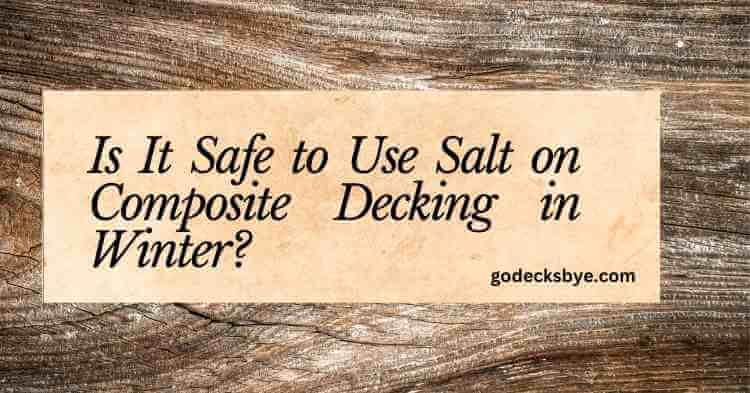Composite decking material is an eco-friendly choice that lasts, yet still manages to impress with its long lifespan. Like wood however, composite is susceptible to food and beverage stains that could mar its finish over time.
For added peace of mind during winter storms, homeowners can use snow and ice melt products such as calcium chloride-based ice melt instead of rock salt to keep their deck safe from slippery conditions. Calcium chloride will be less damaging to composite decking.
Is it Safe?
In areas with harsh winters, snow and ice removal will likely become necessary on your composite deck. When doing so, be mindful of using salt – which may damage composite materials – from sidewalks and parking lots as it could potentially harm them as well as any surrounding composite decks. With proper preparation and attention however, you may still use this form of antifreeze on your composite deck safely.
First, make sure your deck is well swept using a plastic shovel rather than metal to avoid scratches on its surface and loose debris from scratching its surface, which will make removing snow or ice simpler.
When choosing an ice melt, calcium chloride solutions should always be chosen over sodium chloride (rock salt) products due to their lower chlorine concentration levels and less chance of damaging your decking surface. Also, look for calcium chloride ice melt that doesn’t contain additives or tints as this will stop it from discoloring composite decks and keep their color even.
Rock salt ice melts can wreak havoc on wood decking by drawing moisture out, leading to cracking. While premium composite decking materials with low levels of wood cellulose or fir may withstand occasional exposure to rock salt, for maximum investment protection and extended longevity it is wise to opt for alternative non-chemical options like coarse sand or kitty litter instead.
Can it Damage the Deck?
The answer to this question is yes, provided that you use the appropriate type and application of rock salt. Before applying it to your deck, conduct a trial run by spreading some over a small area to see if it causes damage or discoloration; some types contain dyes that could stain its surface if used inappropriately; calcium chloride is recommended as it will neither damage nor discolor composite or PVC decking materials, plus it works at lower temperatures than sodium chloride alternatives.
If you decide to use ice melt, make sure that all loose debris has been cleaned away first before applying the product. A non-metal snow shovel may help prevent scratching of the deck surface; adding coarse sand as an after-salting layer may increase traction and help avoid slipperiness without harming composite materials.
Salting your composite deck should only ever be done as a last resort since frequent salting can damage its structure and shorten its lifespan significantly. Water and salt are highly corrosive to wood; moisture can warp the material, increase cracks and feed mold and mildew growth, leading to warping that requires replacement sooner than anticipated.
Is it Effective?
Salt may work quickly to melt ice and snow away, but its use can also be damaging for composite decks. As sodium chloride attracts moisture from the air, composite materials swell due to water absorption causing cracking, warping, or warp cracking – eventually undermining their structural integrity and shortening lifespans.
To minimize damage, it’s best to limit salt use on decks as much as possible. When necessary, calcium chloride-based “ice melt” products offer less corrosion while providing comparable traction. If children or pets will be using your deck during the winter season, look for products marked “safe for concrete,” “safe for flagstone,” and/or “will not kill grass” on its description page.
Before applying ice melt, sweep the deck area to clear away debris or leaves left from a previous storm, then rinse the entire surface with warm water to prepare for cleaning. Mix soapy water in a bucket in proportion of 1 part soap to 4 parts warm water (similar to how dish washers would handle dishes), dip your deck brush into this solution, and start scrubbing away at any stubborn stains or marks with a soft scrub brush if necessary.
What Should I Do?
If you reside in a cold climate, salting your composite deck during winter may be necessary to keep it looking its best and safe for use. Follow manufacturer recommendations carefully in order to keep it looking its best and remaining safe and beautiful.
Find non-corrosive products. There are ice melts available without chlorides that are safer for composite decks and magnesium chloride-based products may work faster in climates with warmer temperatures compared to rock salt ice melters, not damaging plants as much and not damaging any turf grass or foliage.
Do not use metal shovels or sharp-edged tools on your composite deck as this could scratch its surface. Instead, try using a plastic-tipped shovel that won’t scratch it – this type of shovel won’t do any more harm than any other option available to you!
Sweep away the salt residue as soon as you can and use soapy water sanitization when necessary – this will help eliminate any stains on your composite deck.
Use a household degreaser as soon as oil- or grease-based stains appear on your composite deck to quickly eliminate them; otherwise, they can permanently stain it if left to fester.
Preventative seasonal maintenance will keep your composite deck looking its best and reduce weathering caused by harsh chemicals. Focus on preventing dirt build-up at all seasons, regularly sweep and wash your deck, prune back landscaping to minimize fallen debris, and store outdoor furniture appropriately at the end of every season.
